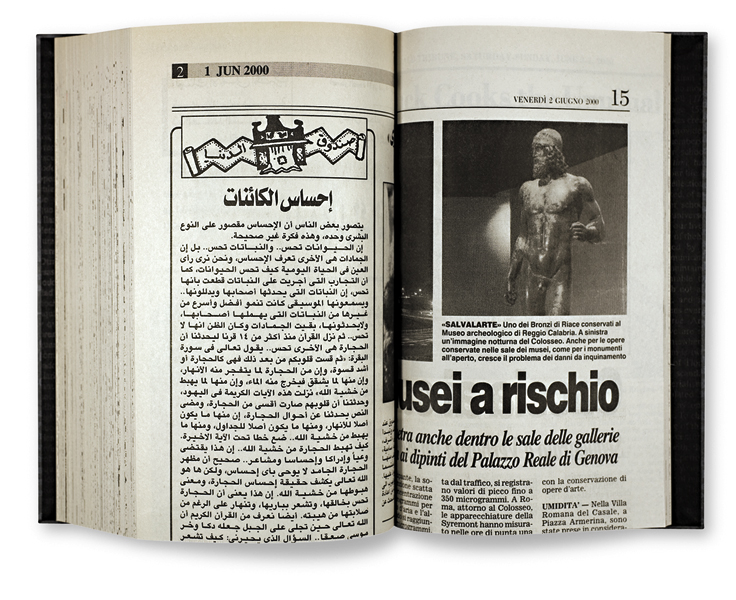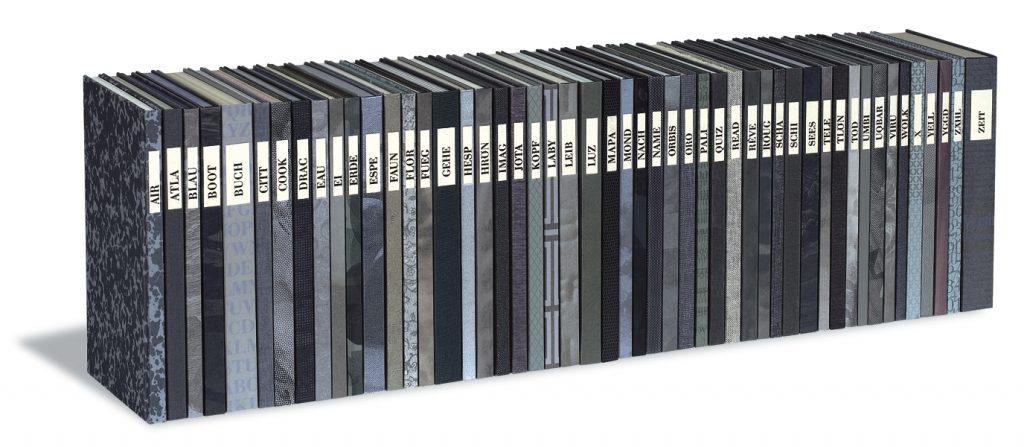In any field of endeavour it is necessary to take note of the very best, to stop and study those extraordinary works. [AIR] These pieces can become a standard against which we assess our work. [ATLAS] They should scare us and inspire us. [BLAU] They should push the boundaries of their field. [BOOT]
In the genre of book arts there is a work that soars above everything else I have yet seen. [BUCH] This work, by German book artists Peter Malutzki and Ines von Ketelhodt, which has its starting point in Jorge Luis Borges’ story Tlön, Uqbar, Orbis Tertius, is the Zweite Enzyklopädie von Tlön. [CITTÀ] In a short blog post of 50 sentences, I can only hint at its scope. [COOKBOOK]
ITS FORM
The work consists of fifty volumes printed in an edition of forty. [DRACHE] Each volume measures 125 x 200 mm but vary in thickness. [EAU] All have a blue grey covering material with each volume having its individual design and/or cloth or paper. [EI]

Von Ketelhodt and Malutzki write: “The limitation to one format, one outer form, was not a problem for us. [ERDE] In hindsight it seems to have been an important prerequisite for the success of the project. [ESPEJO] It is the frame that holds the project together. [FAUNA] We knew the contents of the individual volumes would be very different, determined by our different ways of working. [FLORA] So the volumes’ outer form had to be the common factor.” [FUEGO]

Rather than covering several topics in each volume, as would be the case in a normal encyclopedia, each volume has a keyword and over the set the complete alphabet is covered. [GEHEN]

Von Ketelhodt and Malutzki write: “We had decided that each volume should be dedicated to only one keyword. [HESPOS] Thus the compilation of the right keywords and their interconnectedness was of utmost importance. [HRÖN] The encyclopedia was not to be a patchwork of arbitrary keywords but be a connected whole. [IMAGO] Right from the beginning there were lists of suggested keywords. [JOTA] They were constantly changing, new ones were added, old ones were discarded. [KOPF] Sub-groups were formed: flora and fauna, the three primary colours, the four elements, the title of Borges’ story: Tlön, Uqbar, Orbis Tertius.” [LABYRINTH]

Initially working within a larger group of artists, that early in discussion shrank to a smaller core group, the project was to produce, in thirteen years, the 100 volumes, mentioned in the Borges story. [LEIBNIZ] After the completion of the first volume in 1997 the group split again and von Ketelhodt and Malutzki, holding to the original format, scaled down the project to fifty volumes to be completed in ten years, 1997—2006. [LUZ]

Von Ketelhodt and Malutzki write: “Ten years working on the one project, always in the same (relatively small) format: can it be done? [MAPAMUNDI] We have been asked this question many times. [MOND] And the question is justified particularly when one considers that over the ten years we would only work on this project because it would take absolutely all our energy. [NACHT] Now we can answer ‘yes’ without hesitation; it can be done.” [NAME]

ITS ORIGINS
“Debo a la conjunción de un espejo y de una enciclopedia el descubrimiento de Uqbar.” So begins Jorge Luis Borges his story Tlön, Uqbar, Orbis Tertius, “I owe the discovery of Uqbar to the conjunction of a mirror and an encyclopedia.”
Core to the story is discussion of the history, languages and philosophy of the world of Tlön, a lesser region of Uqbar, gleaned by the narrator from a single volume (Vol. XI, a book of 1001 pages) of A First Encyclopaedia of Tlön, a work of 40 volumes. [ORBIS TERTIUS] The whole existence of Uqbar had been purely conjectural and highly improbable until the narrator finds this volume. [ORO] A postscript further clears the mystery of Tlön and Uqbar, explaining that it was the confabulation of a secret society, Orbis Tertius— the creation of the world and the production of the encyclopedia being its goal. [PALIMPSEST]

At the end of the story the narrator predicts that in a hundred years the one hundred volumes of the Second Encyclopaedia of Tlön will be found. [QUIZ] That A First Encyclopaedia of Tlön was in English and this second, Zweite Enzyklopedie von Tlön is primarily in German, but, in fact, is multilingual. [READER] There are fifty volumes—perhaps, because only fifty years have passed since Borges wrote the story not one hundred, so fifty is the correct number. [RÊVE]

A NEW ENCYCLOPEDIA
It could be argued that the Zweite Enzyklopdedie von Tlön is not really an encyclopedia. [ROUGE] Denis Diderot (1713—1784), the father of encyclopedias, stated that “An encyclopedia … should encompass not only the fields already covered by the academies, but each and every branch of human knowledge.” [SCHATTEN] But is it not a folly to presume that any encyclopedia, (even wikipedia!) can contain “each and every branch of human knowledge”? [SCHIFFFAHRT] So here we have an alternative. [SEESTÜCKE]

The nature of Tlön is disturbingly different to our experience of our world. [TELEVISION] It is this disjuncture, this possibility of otherness that allows von Ketelhodt and Malutzki to create a work that, in essence, is the opposite of an encyclopedia—it does not contain and gesture inwards but rather expands, gesturing outwards, knowing conclusively that all knowledge exists in the world, that the world is the encyclopedia and the role of the book (encyclopedia) is to point us in the direction so that we discover it. [TLÖN] The reader must be agent in the collation of knowledge. [TOD] In the realisation of the work, von Ketelhodt and Malutzki have pushed hard the diversity and levels of reading that can be demanded by the “writer” of the “reader” of an artist’s book. [UMBILICUS] They make the reader work. [UQBAR] But it is worth the effort. [VIRUS] A journey through a rich and eclectic selection of texts and images, carefully choreographed, produced exquisitely using a diverse range of media, the work gestures towards a complex, invigorated, fallible world. [WOLKE] Each volume is distinct, yet each is also only fully complete in the company of the other forty-nine. [X]

A MIRROR
Of the eleventh volume of A First Encyclopaedia of Tlön, the narrator writes: “It is enough to note that the apparent contradictions in the eleventh volume are the basis for proving the existence of the others, so lucid and clear is the scheme maintained in it.” [YELLOW]
Von Ketelhodt and Malutzki write: “We did realize that we could only do justice to our presumptuous ambition of packing the whole world into fifty volumes in details and fragments; but we hoped the found shards would give a notion of the whole structure.” [YGGDRASIL]
Thus, the masterpiece Zweite Enzyklopedie von Tlön refracts the ethereal Tlön of Borges’ story and reflects, more precisely, our world. [ZÄHLEN] To enter the work is to enter a labyrinth of knowledge and imagination and see mirrored the huge possibility of discovering more. [ZEIT]

Note: The Diderot quotation comes from wikipedia. All other quotations, except the last which is from www.tloen-enzyklopaedie.de, come from the catalogue of the work, in which von Ketelhodt and Malutzki discuss the production of the work, the Borges story is reprinted in Spanish, French, German and English and each volume is profiled and illustrated.
The piece was first published in IMPRINT Summer 2014 Vol.49 No.4 journal of the Print Council of Australia

